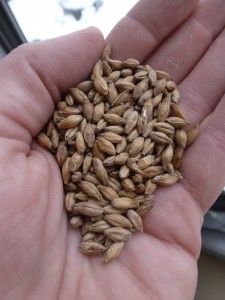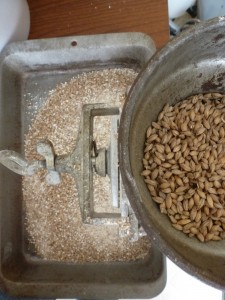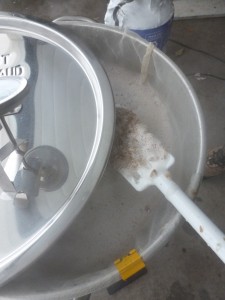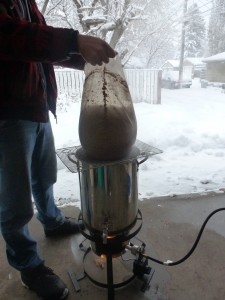As mentioned in the Intro, the primary job of a brewer is to create a fermentable liquid called wort. This involves converting some of the complex starches found in grain to simple sugars, then extracting those sugars into a solution so that yeast can metabolize them and create alcohol, carbon dioxide, and a number of other aromatic and flavourful compounds.
This post is about making wort. It includes info on water, barley, malt, grinding, mashing, lautering, and sparging.
Water. Water is important. Beer is, after all, mostly water. So are we. Historically the water source at a brewery informed the style of beer that they made. Places with alkaline water found that using acidic, heavily roasted malts balanced out the subtle bitterness of their water. This was the case in much of London (think: porter), Dublin (where they make Irish stouts like Guinness), and Munich (home to bocs and dark wheat beers). By comparison, the relatively soft, neutral waters of Pilsen were able to take on a large amount of hops, and became famous for the crisp, bitter lagers they produced. With our modern understanding of water composition, and the advent of regulated, municipal water sources, few brewers actually let their water composition dictate the style of beer they make. More likely they filter water from a municipal source, then add compounds to tailor the liquid to the beer they want to brew. Many homebrewers will buy jugs of spring water to use in brewing. Frankly, water chemistry is very complex, and for my first brew I just used tap water. Seems to have worked okay…
Grains. Many grains can be used in brewing, but barley is by far the most common because it contains a large amount of starch, as well as the right set of enzymes to convert that starch into sugar. Within each grain is a tiny germ, which is the embryo of the plant. Next to the germ is a large mass of starch called the endosperm that will act as food for the growing seedling. The outermost layer of the grain is a tough, fibrous shield called the husk.
 Malting. After harvest kernels of barley destined to become beer are malted. Malting is simply germinating. If you’ve ever sprouted wheat, you’ve made malt. The process is identical: the barley is moistened, and after a few days the kernels grow little sprouts. Malting prompts the germ to produce enzymes that break down the cell walls of the grain and convert some of the starches to sugars. The degree to which the grain is malted is called the modification. It’s measured by the length of the sprout relative to the length of the grain, 100% modification meaning that the sprout is as long as the grain.
Malting. After harvest kernels of barley destined to become beer are malted. Malting is simply germinating. If you’ve ever sprouted wheat, you’ve made malt. The process is identical: the barley is moistened, and after a few days the kernels grow little sprouts. Malting prompts the germ to produce enzymes that break down the cell walls of the grain and convert some of the starches to sugars. The degree to which the grain is malted is called the modification. It’s measured by the length of the sprout relative to the length of the grain, 100% modification meaning that the sprout is as long as the grain.
Kilning. Next the germinated grain is roasted in a kiln. This serves a few purposes: it kills the germ, arresting the production of enzymes and fixing the sugar content; it generates colour and flavour by caramelizing some of the sugars; and it preserves the grain, which after kilning can be stored for months before being used in brewing.
Grains can be kilned to a wide array of colours and flavours. There are several scales by which malt colour is measured, but most homebrewers use degrees Lovibond. Malt on the light end of the spectrum, from say 1 to 15 degrees Lovibond, is called base malt because it is neutral and serves as the main malt in most styles of beer. Darker malts from 15 to 200 degrees Lovibond are called colour malts and are typically used in smaller quantities to add colour and aroma. The far dark end of the spectrum, from 350 to 600 Lovibond includes heavily roasted grain that gives the beer a chocolatey flavour and blackish colour.
Malting and kilning are performed by maltsters. Most homebrewers purchase malt. There is a guy who lives down the street from me that grows barley in his front yard, then malts and kilns it himself. This is the dream. For now I buy malt from the brewshop.
 Grinding. Once the various malts have been combined according to the brewer’s recipe, the mixture is ground to maximize the extraction of starch, sugar, and protein. In most styles of brewing, the husk of the grain will later act as a filter. The goal of grinding is therefore to pulverize the endosperm to a very fine grist, while keeping the husks relatively in tact.
Grinding. Once the various malts have been combined according to the brewer’s recipe, the mixture is ground to maximize the extraction of starch, sugar, and protein. In most styles of brewing, the husk of the grain will later act as a filter. The goal of grinding is therefore to pulverize the endosperm to a very fine grist, while keeping the husks relatively in tact.
I used a hand-driven grain mill that Lisa bought at a garage sale. It actually works great. It takes maybe fifteen minutes to grind the requisite 10 lbs of grain for a 5 gallon batch of beer. Once the malt is ground, it’s called grist.
 Mashing is the word for steeping grist in hot liquor, which is what brewers call water. Basically the malt slurry is held at a set temperature for a couple hours. The temperature is chosen to maximize enzymatic activity. There are many, many ways to mash, ranging from the very simple, to the very complex. Most homebrewers use what is called single infusion mashing. This means that you bring the liquor to a desired temperature, called the strike temperature, then stir in the grain. Our desired mashing temperature was 154°F. Accounting for the fact that the grist will drop the temperature of the liquor, we heated the water to 169°F, then added our malt, which after a couple minutes of stirring, came down to 154°F.
Mashing is the word for steeping grist in hot liquor, which is what brewers call water. Basically the malt slurry is held at a set temperature for a couple hours. The temperature is chosen to maximize enzymatic activity. There are many, many ways to mash, ranging from the very simple, to the very complex. Most homebrewers use what is called single infusion mashing. This means that you bring the liquor to a desired temperature, called the strike temperature, then stir in the grain. Our desired mashing temperature was 154°F. Accounting for the fact that the grist will drop the temperature of the liquor, we heated the water to 169°F, then added our malt, which after a couple minutes of stirring, came down to 154°F.
 Lautering and Sparging. Lautering is separating the grist from the wort. In traditional brewing the husks in the grist settle to the bottom of a tank and form a natural filter through which the wort can be drained. This grain bed can be rinsed with more hot water to wash a bit more starchy sugary goodness from the grist. This process is known as sparging.
Lautering and Sparging. Lautering is separating the grist from the wort. In traditional brewing the husks in the grist settle to the bottom of a tank and form a natural filter through which the wort can be drained. This grain bed can be rinsed with more hot water to wash a bit more starchy sugary goodness from the grist. This process is known as sparging.
Brewing in a bag. There is a modern homebrew method that actually combines mashing and lautering into a single pot. After grinding the malt, we loaded the grist into a jelly bag. For the mashing process, we simply lowered the grain bag into the hot liquor. After mashing, we pulled the bag from the pot, negating the need for traditional lautering. We sparged by pouring hot water over the grist.
At this point we have extracted everything that we need from the grain: it’s “spent,” and can be discarded, or possibly added to your compost, but don’t quote me on that. The next step is to boil the hell out of the wort, and bitter it with hops.